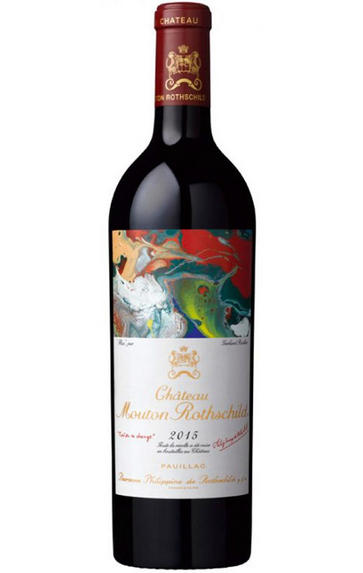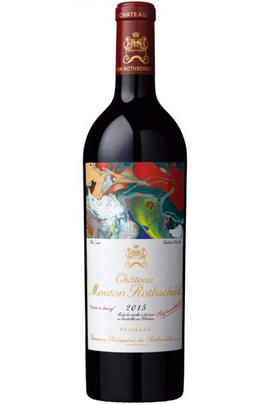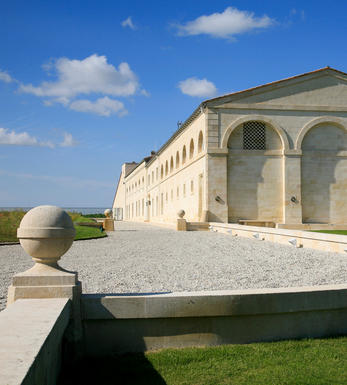
2015 Château Mouton Rothschild, Pauillac, Bordeaux

Critics reviews
The 2015 Mouton-Rothschild has more fruit intensity on the nose than the 2015 Château Margaux and also more red than black fruit: the raspberry and wild strawberry scents are more expressive than the blackberry and briary ones. The oak is neatly integrated here, although I would have liked a little more delineation. The palate is medium-bodied with supple tannin and vivacious red and black fruit, though it is the silky texture that really wins you over. There’s not a single hair out of place on the finish. Perhaps the aromatics just need to up their game. I was expecting a little more.
Neal Martin, Vinous.com (July 2019)
The 2015 is 82% Cabernet Sauvignon, 16% Merlot and 2% Cabernet Franc that spend 19 months in 100% new French oak.
In 2015, Mouton Rothschild is fabulous. A big, towering wine, the 2015 makes its presence felt with layers of super-ripe dense fruit and striking textural resonance that carries all the way through to the finish. The 2015 is much more reticent from bottle than it was from barrel, which is not at all surprising, but is something readers should take into account. Even with all of its obvious intensity, the 2015 Mouton is a wine of classically inspired proportions. I can't wait to taste it in another 15-20 years.
Drink 2025 - 2055
Antonio Galloni, Vinous.com (February 2018)
100% new oak. 11% press wine. Hold +5 years or carafe 6 hours.
Rich and vibrant ruby in colour with violet reflections at 8 years old. This was a warm and generous vintage, and this stunning wine can trick you into believing that it is remarkably approachable already, until the supple but plentiful tannins begin their slow build through the palate. Ripe with blackberry and damson fruit, cocoa bean, toasted sandalwood and fragrant crushed rose aromatics, this takes the architecture and power of Pauillac and gives it lyrical depths. I would resist the temptation to open now, and allow the slow unroll of First Growth complexity to continue for another decade or so.
Drink 2028 - 2050
Jane Anson, JaneAnson.com (June 2023)
The 2015 Mouton Rothschild is a blend of 82% Cabernet Sauvignon, 16% Merlot and 2% Cabernet Franc aged in 100% new oak with a mid-July 2017 bottling. Deep garnet-purple coloured, this Mouton pulls off an incredibly impactful entrance, emerging from the glass with profound notes of blackberry preserves, plum pudding, creme de cassis and grilled meats, featuring perfectly accessorized accents of sandalwood, cinnamon stick and fenugreek with wafts of dried roses, unsmoked cigars and tilled soil.
Medium to full-bodied, the palate is completely packed with rich, ripe black fruits sparked with blue and red fruit undertones and an incredible structure of very firm, very ripe tannins, with seamless freshness and an epically long, earth-laced finish. This 2015 is a total diva and well worth attention, possessing striking natural beauty framed by impeccable crafting.
Give it a good 7-8 years in bottle, and drink it over the next 30+ years.
Lisa Perrotti-Brown, Wine Advocate (February 2018)
Very majestic nose. Obviously first-growth quality. Savoury and plush in terms of texture. Restrained without being a wimp. Lovely scent. Dry finish but with some of Mouton's opulence before then. Very fine. Very exciting. Some saline sap as well as all the ripe fruit.
Drink 2025 - 2045
Jancis Robinson, JancisRobinson.com (April 2016)
Very racy and refined with super polished tannins and focused dark fruits. Blackberry, orange peel, and black currants. Full. Very long and thought-provoking. A wine that delivers power and finesse. Juicy and fresh.
James Suckling, JamesSuckling.com (April 2016)
My joint top wine (with Ch Margaux) of the vintage. A real firework display but still controlled. Very rich on the palate: broad yet silky, earthy yet so refined. This is Mouton at a new peak and it’s hard to imagine a better balance of elegance and power.
Drink 2024 - 2050
Steven Spurrier, Decanter.com (April 2016)
In contrast to the precise, backward, yet massive 2016, the 2015 Château Mouton Rothschild offers a gorgeous, up-front, spicy perfume of spiced black and blue fruits, smoked tobacco, new leather, and lead pencil shavings. These carry to a full-bodied, deep, rich, layered, incredibly sexy wine that has beautiful tannins, flawless balance, and a great, great finish. More in the style of the 2009, this already offers pleasure today yet will nevertheless evolve for 50+ years.
Drink 2023 - 2075
Jeb Dunnuck, JebDunnuck.com (May 2023)
About this WINE

Château Mouton Rothschild
Classified as a First Growth, Château Mouton Rothschild has a long and storied history; wine has been made here since Roman times. The property spans 82 hectares of vines in Pauillac, planted with the classic varieties of the region, Cabernet Sauvignon being predominant.
The estate has been in the Baron Philippe de Rothschild family since 1853, but it wasn’t until the arrival of Baron Philippe de Rothschild in 1922 that its fortunes were transformed. Baron Philippe was a dynamic figure who revolutionised the estate and was the first to introduce château-bottling in 1924. He also introduced the concept of commissioning an artist to design each new vintage’s label. Some of the most notable contributors include Salvador Dalí, Henry Moore, Marc Chagall, Francis Bacon, Lucian Freud, Anish Kapoor and Peter Doig.
His daughter Baroness Philippine continued to help raise the estate to new heights with numerous endeavours, including the inauguration of a new vat house in 2013. Today, her three children, Camille and Philippe Sereys de Rothschild and Julien de Beaumarchais de Rothschild, continue the efforts of their predecessors.
Following the retirement in 2020 of Philippe Dhalluin, the winemaking team is now headed up by Jean-Emmanuel Danjoy. With his team, he oversees over 83 hectares of vines, planted with Cabernet Sauvignon (78%), Merlot (18%), Cabernet Franc (3%), and Petit Verdot (1%). The average age of the vines is around 50 years.

Pauillac
Pauillac is the aristocrat of the Médoc boasting boasting 75 percent of the region’s First Growths and with Grand Cru Classés representing 84 percent of Pauillac's production.
For a small town, surrounded by so many familiar and regal names, Pauillac imparts a slightly seedy impression. There are no grand hotels or restaurants – with the honourable exception of the establishments owned by Jean-Michel Cazes – rather a small port and yacht harbour, and a dominant petrochemical plant.
Yet outside the town, , there is arguably the greatest concentration of fabulous vineyards throughout all Bordeaux, including three of the five First Growths. Bordering St Estèphe to the north and St Julien to the south, Pauillac has fine, deep gravel soils with important iron and marl deposits, and a subtle, softly-rolling landscape, cut by a series of small streams running into the Gironde. The vineyards are located on two gravel-rich plateaux, one to the northwest of the town of Pauillac and the other to the south, with the vines reaching a greater depth than anywhere else in the Médoc.
Pauillac's first growths each have their own unique characteristics; Lafite Rothschild, tucked in the northern part of Pauillac on the St Estèphe border, produces Pauillac's most aromatically complex and subtly-flavoured wine. Mouton Rothschild's vineyards lie on a well-drained gravel ridge and - with its high percentage of Cabernet Sauvignon - can produce (in its best years) Pauillac's most decadently rich, fleshy and exotic wine.
Latour, arguably Bordeaux's most consistent First Growth, is located in southern Pauillac next to St Julien. Its soil is gravel-rich with superb drainage, and Latour's vines penetrate as far as five metres into the soil. It produces perhaps the most long-lived wines of the Médoc.
Recommended Châteaux
Ch. Lafite-Rothschild, Ch. Latour, Ch. Mouton-Rothschild, Ch. Pichon-Longueville Baron, Ch. Pichon Longueville Comtesse de Lalande, Ch. Lynch-Bages, Ch. Grand-Puy-Lacoste, Ch, Pontet-Canet, Les Forts de Latour, Ch. Haut-Batailley, Ch. Batailley, Ch. Haut-Bages Libéral.

Cabernet Sauvignon Blend
Cabernet Sauvignon lends itself particularly well in blends with Merlot. This is actually the archetypal Bordeaux blend, though in different proportions in the sub-regions and sometimes topped up with Cabernet Franc, Malbec, and Petit Verdot.
In the Médoc and Graves the percentage of Cabernet Sauvignon in the blend can range from 95% (Mouton-Rothschild) to as low as 40%. It is particularly suited to the dry, warm, free- draining, gravel-rich soils and is responsible for the redolent cassis characteristics as well as the depth of colour, tannic structure and pronounced acidity of Médoc wines. However 100% Cabernet Sauvignon wines can be slightly hollow-tasting in the middle palate and Merlot with its generous, fleshy fruit flavours acts as a perfect foil by filling in this cavity.
In St-Emilion and Pomerol, the blends are Merlot dominated as Cabernet Sauvignon can struggle to ripen there - when it is included, it adds structure and body to the wine. Sassicaia is the most famous Bordeaux blend in Italy and has spawned many imitations, whereby the blend is now firmly established in the New World and particularly in California and Australia.


Buying options
Add to wishlist
Description
82% Cabernet Sauvignon, 16% Merlot, 2% Cabernet Franc.
The 2015 Ch. Mouton Rothschild is simply outstanding. It has a superb cool and racy palate brimming with Cabernet fruit. There is the ripeness, flair and gravitas you would expect from a First Growth and a very long, succulent finish. The rich, intoxicating nose is extremely exciting, I just love the racy, pure cassis notes. The silky core of fruit is absolutely delicious. This is a really strong wine from a vintage which is justifiably rated highly. The crunch of fruit, a hallmark of the vintage, is present and utterly refreshing.
Berry Bros. & Rudd
wine at a glance
Delivery and quality guarantee